Verdict
Turn your system into a wireless streaming system easily and with very agreeable results. The MXN10 is this close to ideal.
Pros
- Eloquent, driving sound
- Compact and discreet
- Handy control app
Cons
- Really needs a volume control
- Lacking some treble sparkle
- Higher-resolution Bluetooth codec compatibility would be nice
-
Sample ratesMaximum sample rates: DSD512, 32bit/784kHz -
InputsDual-band Wi-Fi; Bluetooth 5.0 (SBC, AAC); Ethernet; USB-A
Introduction
It’s been made pretty plain over the last few years that Cambridge Audio knows precisely what’s what when it comes to delivering accomplished digital audio streamers at realistic prices.
With the MXN10 it’s determined to redefine realistic and bring the joys of wireless music streaming to those proud owners of legacy hi-fi set-ups who don’t want to junk their beloved systems simply to get a bit of digital streaming functionality. Which is all well and good – laudable, even – but is the MXN10 up to the task?
Availability
- UKRRP: £449
- USARRP: $499
- EuropeRRP: €499
- CanadaTBC
- AustraliaRRP: AU$899
The Cambridge Audio MXN10 is on sale now, and in the United Kingdom it sells for £449. In the United States you’re looking at $499, while in Australia it goes for AU$899.
That this is very competitive money for a full-on digital audio streamer (even one in a smaller-than-average chassis) is obvious. Price-comparable alternatives are about as thin on the ground as size-comparable rivals. It seems that the MXN10 is halfway to being a success before it’s even plugged in – but, as we know, things can sometimes go south very quickly…
Design
- Dimensions (HxWxD, mm): 52 x 215 x 191
- Weight (kg): 1.2
- Lunar grey finish
Discretion is the word I’ll be applying here. Anyone familiar with Cambridge Audio’s wildly successful range of DACs and phono stages will recognise the 52 x 215 x 191mm (HxWxD) dimensions of the MXN10 – it’s a compact and unassuming device.
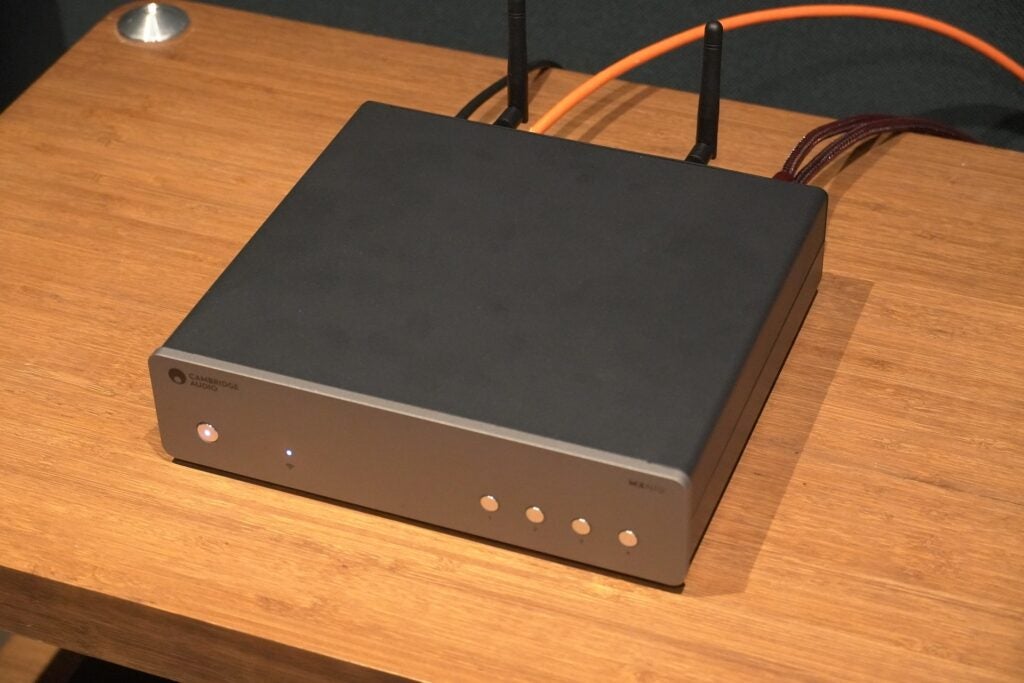
Which means it’s ideal for use either in a full-on hi-fi system, say, or as a source for a wireless speaker. Aside from mains power, it seems likely only one of its outputs will require any cabling – so no matter where it’s positioned, it’s unlikely to disrupt your feng shui.
The lunar grey finish is pretty much standard across the entire Cambridge Audio range, so (unless you’re one of the lucky few who secured one of the limited-edition black components) it will look the part in amongst the rest of your system. Provided it’s a Cambridge Audio system, anyhow.
Feature
- ESS Sabre ES9033Q DAC
- Physical and wireless connectivity
- Bluetooth 5.0 with SBC and AAC compatibility
Yes, it’s affordable by the previous standards of Cambridge Audio music streamers, and no it doesn’t have any kind of fascia display. But neither of these things should make you imagine the MXN10 is short of features.
On the inside, the serious business is taken care of by an ESS Sabre ES9033Q DAC that’s capable of dealing with digital audio files of up the 32-bit/784kHz and DSD512 resolution. It can handle popular file types like MP3, ALAC, FLAC, and WAV – and quite a few unpopular alternatives too.
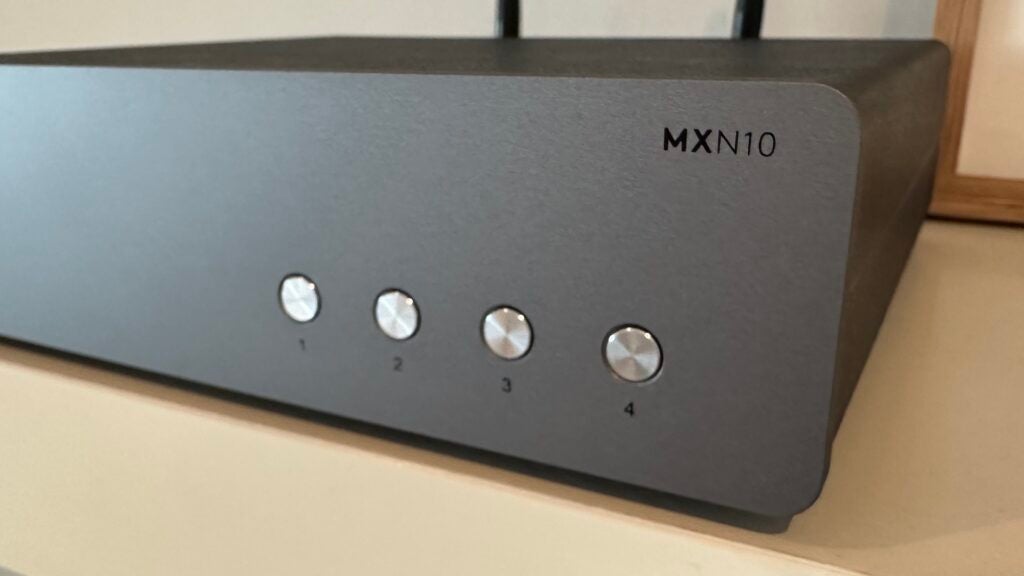
The front of the MXN10 is minimal (or virtually featureless if you prefer). There’s a power button, and four similarly sized buttons giving access to four presets – these can be radio stations, playlists, or what-have-you.
On the rear, meanwhile, there are a couple of wireless aerials (for dual-band Wi-fi and Bluetooth 5.0), an Ethernet socket and a USB-A slot for use with mass-storage drives. Outputs extend to a pair of analogue stereo RCAs, digital optical and digital coaxial sockets.
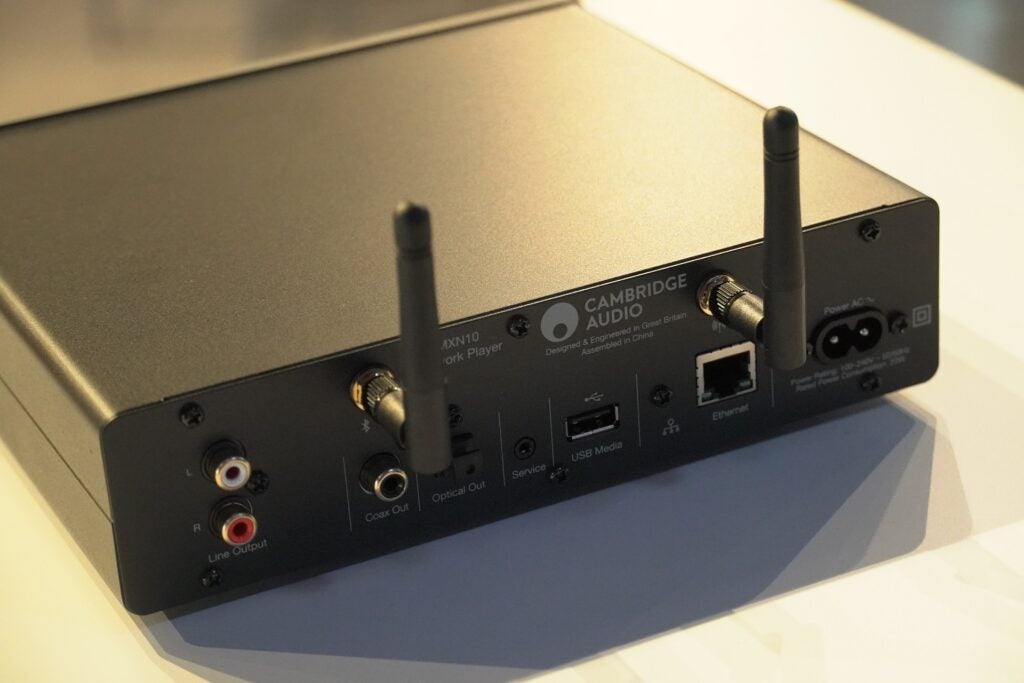
Control mostly happens using the fourth generation of Cambridge Audio’s StreamMagic control app. Here’s where you get access to internet radio, Spotify Connect, Deezer, Qobuz and TIDAL Connect. Chromecast and Apple Airplay 2 are built in, and the MXN10 is both Roon Ready and UPnP-compatible.
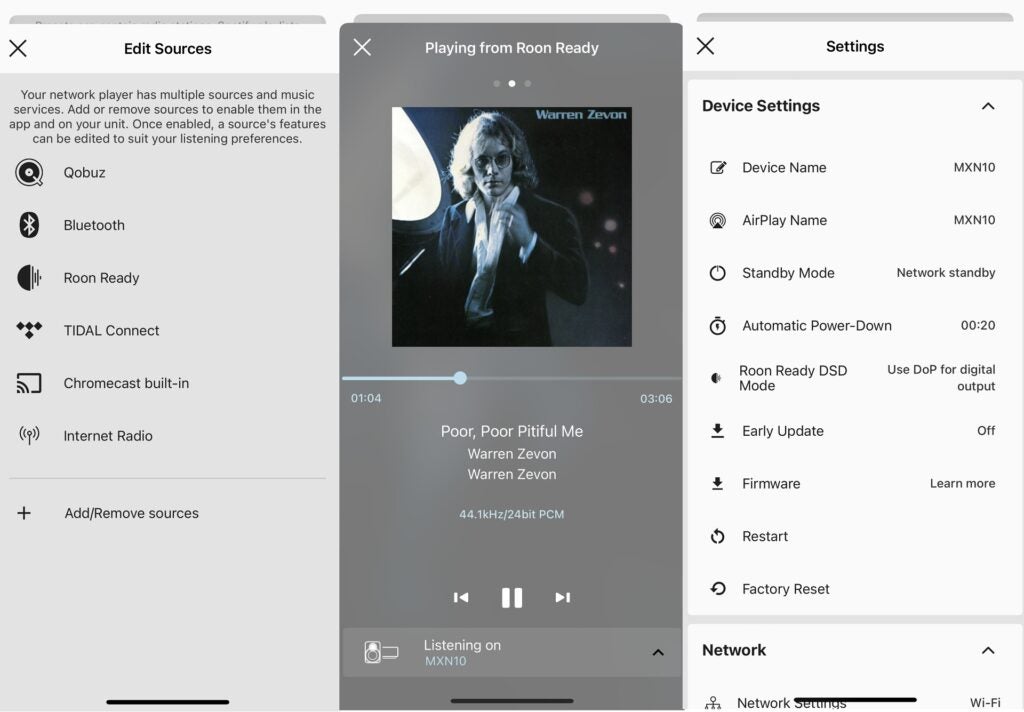
The app also lets you (among things) check for firmware updates, define the function of those four preset buttons, and specify the amount of time you’d like MXN10 to stay powered up when it’s not receiving a signal.
There’s no volume control available, though, which is mildly vexatious. The fixed gain output means that in order to control the volume, you’ll either have to use the physical control on your amplifier/wireless speaker/whatever, or open the app of the streaming service or similar that you’re using – and control the volume from there. It’s an inelegant and inconvenient solution and is quite strongly at odds with the rest of the MXN10’s elegant and convenient ergonomic experience.
Sound Quality
- Detailed, spacious and full-scale sound
- Not quite assertive enough where treble is concerned
- Dynamic and entertaining in equal measure
That the Cambridge Audio MXN10 does its best work when given some chunky, information-rich Hi-Res audio files to deal with should come as no surprise. What might, though, is that it really isn’t too picky – so if you’re feeding it relatively low-res stuff from, say, Spotify’s free tier it’s not about to turn its nose up. ‘It’s all good’ would seem to be the attitude here.
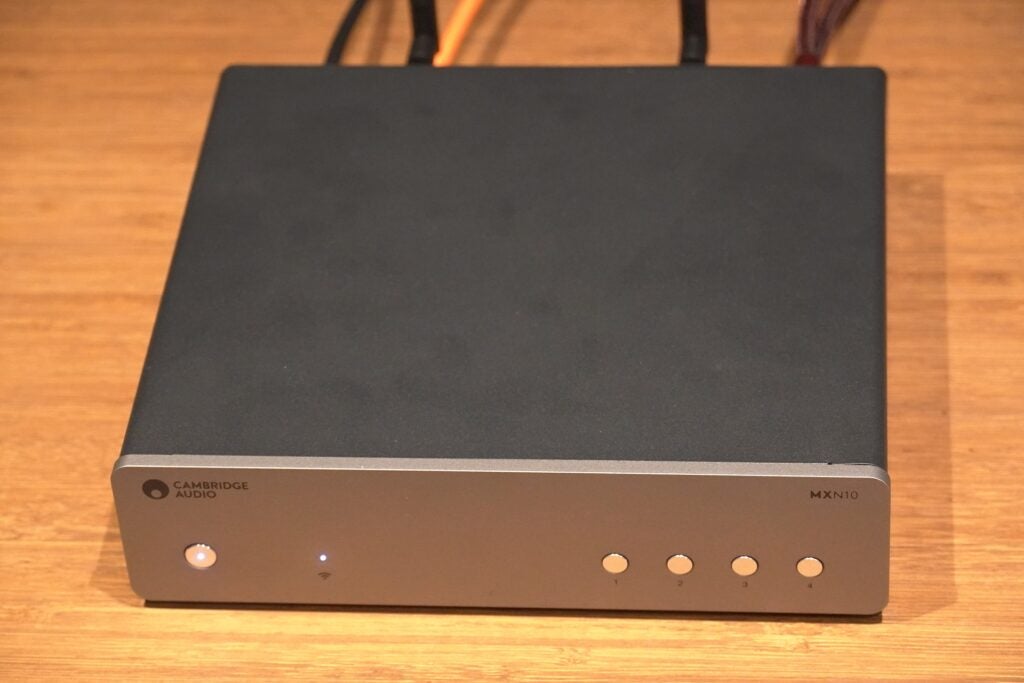
So to find out what the MXN10 can do it’s connected to a stereo amplifier via its analogue RCA outputs (in order to take care of both streaming and digital-to-analogue conversion), which is in turn connected to a pair of stereo speakers. It’s connected to the same network as a NAS drive full of high-resolution content, and the StreamMagic app is given access to a Qobuz account. After that, it’s just a question of sitting back to listen.
And it’s fair to say the Cambridge Audio is a robust and fairly energetic listen. With a big FLAC file of Run The Jewels’ Walking in the Snow playing, it generates considerable low-frequency presence. Bass is deep and textured, with plenty of attention paid to the control of attack and decay of individual sounds. The MXN10 uses this low-end authority to underpin the rest of the recording and to give the square, boom-bap rhythm proper expression.
It’s really poised and detailed through the midrange, too – some audio equipment likes to push this area of the frequency range forward (presumably) in an effort to allow vocalists to take centre stage, but the MXN10 doesn’t need to do that. Its soundstage is big and properly laid out, so there’s more than enough room for a singer (or a rapper) to do their thing in the most natural and articulate way while remaining an integral part of the overall presentation.
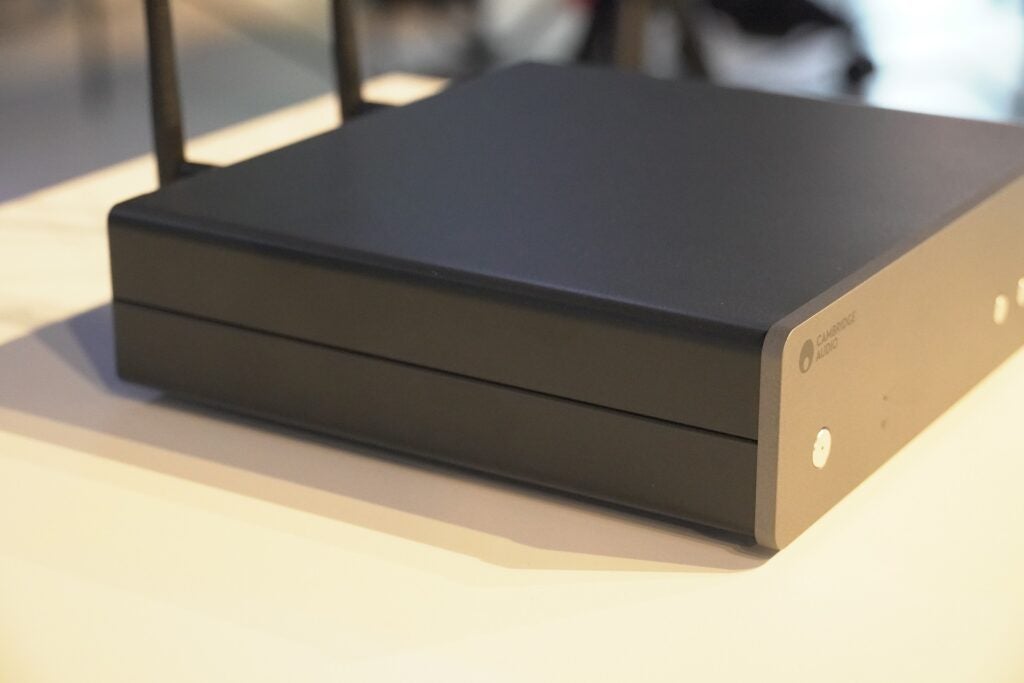
The top of the frequency range is just slightly rolled off, and consequently misses out on the outright bite and crunch this recording ordinarily enjoys. It’s not a fatal flaw by any means, but it’s worth noting – if the system you want to introduce the MXN10 is already circumspect where the top of the frequency range is concerned, you’ll want to think long and hard about whether this Cambridge Audio is appropriate. The fact that its overall tonality is just slightly on the warm side of neutral should be a consideration too, but not one of quite such significance.
Otherwise, though, the good news just keeps on coming. There’s more than enough dynamic headroom available for the MXN10 to make big shifts in volume and/or intensity obvious. It’s equally adept at teasing out the low-level harmonic variations that should be apparent when listening to, say, a solo piano or voice. And in all circumstances, the Cambridge Audio’s engagement with the music you’re playing is almost palpable. This is not an analytical or dispassionate device, far from it.
Latest deals
Click here to check the price of the MXN10
Should you buy it?
You want to add streaming smarts to your existing system: The MXN10 is simple to set-up, easy to use and sounds the money’s-worth.
That existing system isn’t as assertive with treble as it might be: That’s a trait the MXN10 might well compound.
Final Thoughts
“Cambridge Audio in brilliant value-for-money shocker!” said no headline, ever. That the MXN10 would be entirely fit for purpose was never really in any doubt, was it?
It’s the right product, at the right time, at the right price and in the right-sized chassis. Suddenly even the most retro/vintage/whatever system can be brought right up to date, at next-to no effort and at very reasonable cost. With the MXN10, Cambridge Audio is just Cambridge Audio-ing…
How we test
We test every music streamer we review thoroughly over an extended period of time. We use industry standard tests to compare features properly. We’ll always tell you what we find. We never, ever, accept money to review a product.
Find out more about how we test in our ethics policy.
Tested for more than a week
Tested with real world use
FAQs
The main difference between the AXN10 and MXN10 is the size of the chassis. The AXN10 is a full-width streamer while the MXN10 is more compact. In terms of their internals, these streamers are identical.
Sustainability
Trusted Reviews’ holds the fact that global warming is not a myth as a core value and will continuously endeavour to help protect our planet from harm in its business practices.
As part of this mission, whenever we review a product we send the company a series of questions to help us gauge and make transparent the impact the device has on the environment.
We currently haven’t received answers to the questions on this product, but will update this page the moment we do. You can see a detailed breakdown of the questions we ask and why in our sustainability info page.
Jargon buster
Hi-Res Audio
Hi-Res audio is referred to as a standard as well as a marketing term that describes digital audio files of better-than-CD quality (16-bit/44.1kHz).
AirPlay 2
AirPlay 2 is the second generation of Apple’s proprietary wireless streaming tech, which is built into all of its hardware products (and supported by many others). It’s designed to pass content from your Apple device – music, video and photos – to a compatible receiver over your Wi-Fi network such as a TV, wireless speaker, AV receiver etc.
Verdict
Turn your system into a wireless streaming system easily and with very agreeable results. The MXN10 is this close to ideal.
Pros
- Eloquent, driving sound
- Compact and discreet
- Handy control app
Cons
- Really needs a volume control
- Lacking some treble sparkle
- Higher-resolution Bluetooth codec compatibility would be nice
-
Sample ratesMaximum sample rates: DSD512, 32bit/784kHz -
InputsDual-band Wi-Fi; Bluetooth 5.0 (SBC, AAC); Ethernet; USB-A
Introduction
It’s been made pretty plain over the last few years that Cambridge Audio knows precisely what’s what when it comes to delivering accomplished digital audio streamers at realistic prices.
With the MXN10 it’s determined to redefine realistic and bring the joys of wireless music streaming to those proud owners of legacy hi-fi set-ups who don’t want to junk their beloved systems simply to get a bit of digital streaming functionality. Which is all well and good – laudable, even – but is the MXN10 up to the task?
Availability
- UKRRP: £449
- USARRP: $499
- EuropeRRP: €499
- CanadaTBC
- AustraliaRRP: AU$899
The Cambridge Audio MXN10 is on sale now, and in the United Kingdom it sells for £449. In the United States you’re looking at $499, while in Australia it goes for AU$899.
That this is very competitive money for a full-on digital audio streamer (even one in a smaller-than-average chassis) is obvious. Price-comparable alternatives are about as thin on the ground as size-comparable rivals. It seems that the MXN10 is halfway to being a success before it’s even plugged in – but, as we know, things can sometimes go south very quickly…
Design
- Dimensions (HxWxD, mm): 52 x 215 x 191
- Weight (kg): 1.2
- Lunar grey finish
Discretion is the word I’ll be applying here. Anyone familiar with Cambridge Audio’s wildly successful range of DACs and phono stages will recognise the 52 x 215 x 191mm (HxWxD) dimensions of the MXN10 – it’s a compact and unassuming device.

Which means it’s ideal for use either in a full-on hi-fi system, say, or as a source for a wireless speaker. Aside from mains power, it seems likely only one of its outputs will require any cabling – so no matter where it’s positioned, it’s unlikely to disrupt your feng shui.
The lunar grey finish is pretty much standard across the entire Cambridge Audio range, so (unless you’re one of the lucky few who secured one of the limited-edition black components) it will look the part in amongst the rest of your system. Provided it’s a Cambridge Audio system, anyhow.
Feature
- ESS Sabre ES9033Q DAC
- Physical and wireless connectivity
- Bluetooth 5.0 with SBC and AAC compatibility
Yes, it’s affordable by the previous standards of Cambridge Audio music streamers, and no it doesn’t have any kind of fascia display. But neither of these things should make you imagine the MXN10 is short of features.
On the inside, the serious business is taken care of by an ESS Sabre ES9033Q DAC that’s capable of dealing with digital audio files of up the 32-bit/784kHz and DSD512 resolution. It can handle popular file types like MP3, ALAC, FLAC, and WAV – and quite a few unpopular alternatives too.

The front of the MXN10 is minimal (or virtually featureless if you prefer). There’s a power button, and four similarly sized buttons giving access to four presets – these can be radio stations, playlists, or what-have-you.
On the rear, meanwhile, there are a couple of wireless aerials (for dual-band Wi-fi and Bluetooth 5.0), an Ethernet socket and a USB-A slot for use with mass-storage drives. Outputs extend to a pair of analogue stereo RCAs, digital optical and digital coaxial sockets.

Control mostly happens using the fourth generation of Cambridge Audio’s StreamMagic control app. Here’s where you get access to internet radio, Spotify Connect, Deezer, Qobuz and TIDAL Connect. Chromecast and Apple Airplay 2 are built in, and the MXN10 is both Roon Ready and UPnP-compatible.

The app also lets you (among things) check for firmware updates, define the function of those four preset buttons, and specify the amount of time you’d like MXN10 to stay powered up when it’s not receiving a signal.
There’s no volume control available, though, which is mildly vexatious. The fixed gain output means that in order to control the volume, you’ll either have to use the physical control on your amplifier/wireless speaker/whatever, or open the app of the streaming service or similar that you’re using – and control the volume from there. It’s an inelegant and inconvenient solution and is quite strongly at odds with the rest of the MXN10’s elegant and convenient ergonomic experience.
Sound Quality
- Detailed, spacious and full-scale sound
- Not quite assertive enough where treble is concerned
- Dynamic and entertaining in equal measure
That the Cambridge Audio MXN10 does its best work when given some chunky, information-rich Hi-Res audio files to deal with should come as no surprise. What might, though, is that it really isn’t too picky – so if you’re feeding it relatively low-res stuff from, say, Spotify’s free tier it’s not about to turn its nose up. ‘It’s all good’ would seem to be the attitude here.

So to find out what the MXN10 can do it’s connected to a stereo amplifier via its analogue RCA outputs (in order to take care of both streaming and digital-to-analogue conversion), which is in turn connected to a pair of stereo speakers. It’s connected to the same network as a NAS drive full of high-resolution content, and the StreamMagic app is given access to a Qobuz account. After that, it’s just a question of sitting back to listen.
And it’s fair to say the Cambridge Audio is a robust and fairly energetic listen. With a big FLAC file of Run The Jewels’ Walking in the Snow playing, it generates considerable low-frequency presence. Bass is deep and textured, with plenty of attention paid to the control of attack and decay of individual sounds. The MXN10 uses this low-end authority to underpin the rest of the recording and to give the square, boom-bap rhythm proper expression.
It’s really poised and detailed through the midrange, too – some audio equipment likes to push this area of the frequency range forward (presumably) in an effort to allow vocalists to take centre stage, but the MXN10 doesn’t need to do that. Its soundstage is big and properly laid out, so there’s more than enough room for a singer (or a rapper) to do their thing in the most natural and articulate way while remaining an integral part of the overall presentation.

The top of the frequency range is just slightly rolled off, and consequently misses out on the outright bite and crunch this recording ordinarily enjoys. It’s not a fatal flaw by any means, but it’s worth noting – if the system you want to introduce the MXN10 is already circumspect where the top of the frequency range is concerned, you’ll want to think long and hard about whether this Cambridge Audio is appropriate. The fact that its overall tonality is just slightly on the warm side of neutral should be a consideration too, but not one of quite such significance.
Otherwise, though, the good news just keeps on coming. There’s more than enough dynamic headroom available for the MXN10 to make big shifts in volume and/or intensity obvious. It’s equally adept at teasing out the low-level harmonic variations that should be apparent when listening to, say, a solo piano or voice. And in all circumstances, the Cambridge Audio’s engagement with the music you’re playing is almost palpable. This is not an analytical or dispassionate device, far from it.
Latest deals
Click here to check the price of the MXN10
Should you buy it?
You want to add streaming smarts to your existing system: The MXN10 is simple to set-up, easy to use and sounds the money’s-worth.
That existing system isn’t as assertive with treble as it might be: That’s a trait the MXN10 might well compound.
Final Thoughts
“Cambridge Audio in brilliant value-for-money shocker!” said no headline, ever. That the MXN10 would be entirely fit for purpose was never really in any doubt, was it?
It’s the right product, at the right time, at the right price and in the right-sized chassis. Suddenly even the most retro/vintage/whatever system can be brought right up to date, at next-to no effort and at very reasonable cost. With the MXN10, Cambridge Audio is just Cambridge Audio-ing…
How we test
We test every music streamer we review thoroughly over an extended period of time. We use industry standard tests to compare features properly. We’ll always tell you what we find. We never, ever, accept money to review a product.
Find out more about how we test in our ethics policy.
Tested for more than a week
Tested with real world use
FAQs
The main difference between the AXN10 and MXN10 is the size of the chassis. The AXN10 is a full-width streamer while the MXN10 is more compact. In terms of their internals, these streamers are identical.
Sustainability
Trusted Reviews’ holds the fact that global warming is not a myth as a core value and will continuously endeavour to help protect our planet from harm in its business practices.
As part of this mission, whenever we review a product we send the company a series of questions to help us gauge and make transparent the impact the device has on the environment.
We currently haven’t received answers to the questions on this product, but will update this page the moment we do. You can see a detailed breakdown of the questions we ask and why in our sustainability info page.
Jargon buster
Hi-Res Audio
Hi-Res audio is referred to as a standard as well as a marketing term that describes digital audio files of better-than-CD quality (16-bit/44.1kHz).
AirPlay 2
AirPlay 2 is the second generation of Apple’s proprietary wireless streaming tech, which is built into all of its hardware products (and supported by many others). It’s designed to pass content from your Apple device – music, video and photos – to a compatible receiver over your Wi-Fi network such as a TV, wireless speaker, AV receiver etc.























